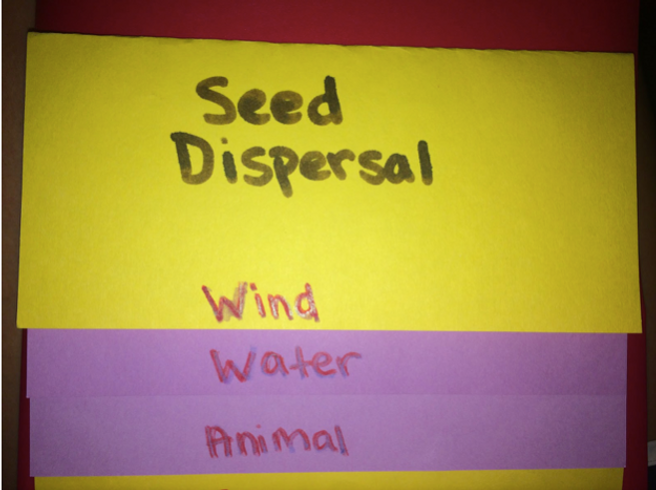
Assessment Activity
Assessment Activity
GRADE: 2nd Grade
ELD STANDARD 4: The Language of Science
EXAMPLE TOPIC: Seed Dispersal
CONNECTION: Colorado Academic Standards for Science, Standard 2. Life Science:
1. Plants depend on water and light to grow and on animals for pollination or to move their seeds around.
B. Develop a simple model that mimics the function of an animal in dispersing seeds or pollinating plants. (2-LS2-2)
EXAMPLE CONTEXT FOR LANGUAGE USE: Students learn about the process of seed dispersal (wind, water, and animals) in small groups to produce flipbooks.
COGNITIVE FUNCTION: Students at all levels of English language proficiency APPLY understanding of the different ways that seeds disperse (wind, water, animals).
TOPIC-RELATED LANGUAGE: Students at all levels of English language proficiency interact with grade-level words and expression, such as: wind, water, animals, seed dispersal/disperse, pollination, habitat.

Lesson 3: Intro to How Seeds Move
Grade Level/Duration:
Second Grade/55 minutes
Unit Objective(s):
Students will learn about the parts of a plant, the needs of a plant, and movement of seeds through dispersal by conducting experiments, creating diagrams and drawings, discussing in groups, and creating models during class.
Lesson Objectives:
Colorado Academic Standards for Science, Standard 2. Life Science:
1. Plants depend on water and light to grow and on animals for pollination or to move their seeds around.
B. Develop a simple model that mimics the function of an animal in dispersing seeds or pollinating plants. (2-LS2-2)
Materials:
-
Book- Read “Who Will Plant a Tree?” by Jerry Pallotta
-
Construction paper
-
Markers
-
Crayons
-
Color pencils
-
Glue
-
Stapler
Engage:
To start the lesson, ask students how they think seeds can be moved from one place to another? After students are done sharing, let them know if we’ll find out more by reading “Who Will Plant a Tree?” by Jerry Pallotta
After reading the book, ask students to turn and talk to a neighbor and share what new way they found out that a seed can be moved.
Then briefly discuss the three ways plants can be moved from one place to another by wind, water, and animals. Inform students that this is called dispersal.
Explore:
To help students gain a better understanding of how plants survive and grow in their habitats through seed dispersal, they will create a 4 layered look-book using two sheets of paper. Provide an example/model of what the book should look like and so the students can refer back to the model. Students will label their tabs: Tab 1- Wind, Tab 2- Water, Tab 3- Animal. The students will be grouped to have 3 partners to work together on completing their layered look-book. For each tab, the students will identify how each factors play a role in dispersing seeds and then below each explanation they can draw an example of their explanation. The students will have the opportunity to work with one another and explore the different kinds of seed dispersal there are that help plants grow in different areas (habitats).
Provide the following guiding questions to help students identify the ways seeds are dispersed:
-
How do the wind, water, and animals disperse/move seeds?
-
Are there other ways that seeds can be dispersed?
-
What some way seeds are pollinated?
Explain:
When students are done with creating their 4-layered look-book, have them circle up on the carpet and share their seed dispersal books. One group member will share their information from their group book with the class. After sharing ask students why do you think seed dispersal is important for plants?
After the discussion, ask the class what they discovered about the different types of seed dispersal. Then share with the class that seeds can also be dispersed through explosion and explain how.
Vocabulary:
-
Dispersed/Dispersal
-
Pollination
-
Habitat
Elaboration:
Ask students how can use the information about seed dispersal to help explain how this helps plants live? Do you think some seeds that are dispersed outside of their habitat survive? Why and Why not?
Evaluation:
Students will show an understanding of seed dispersal of plants by their completion of their book and through class discussions by answering questions.
Accommodations or Modifications:
The creation of layered book is to help students understand the different ways seeds can be dispersed. Students don’t have to work with partners if they don’t want to, but working with partners is a way of having students collaborate with one another and work together to come up with different ideas of how seeds can be dispersed through water, wind, and animals. Vocabulary words will also be defined as they are used in the lesson and the teacher will be there to assist students when needed.
Resources:
Book- “Who Will Plant a Tree?” by Jerry Pallotta
Example of seed dispersal 4-layered look-book:

Citations:
-
Colorado Department of Education. (n.d.). 2020 Colorado Academic Standards Online. Retrieved March 17, 2019, from https://www.cde.state.co.us/apps/standards/
-
WIDA. (n.d.). Can Do Descriptors. Retrieved March 17, 2019, from https://wida.wisc.edu/teach/can-do/descriptors
-
Wright, Wayne E. Foundations for Teaching English Language Learners: Research, Theory, Policy, and Practice. Philadelphia: Caslon, 2015. Print